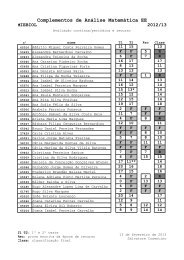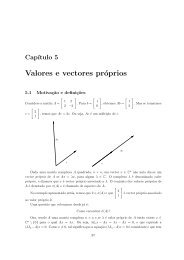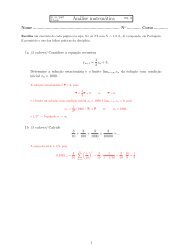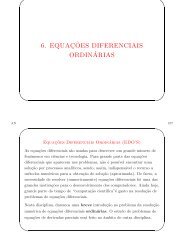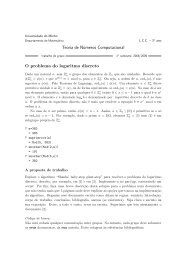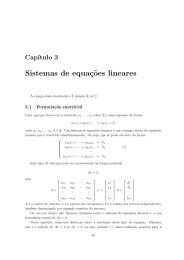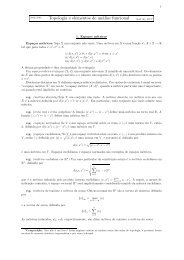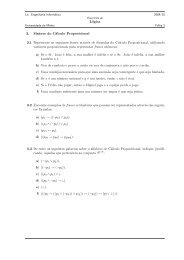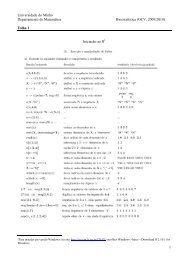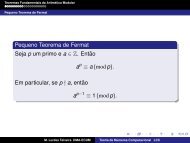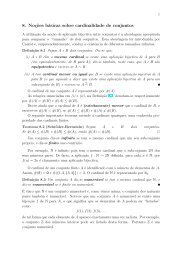My title - Departamento de Matemática da Universidade do Minho
My title - Departamento de Matemática da Universidade do Minho
My title - Departamento de Matemática da Universidade do Minho
Create successful ePaper yourself
Turn your PDF publications into a flip-book with our unique Google optimized e-Paper software.
6 FLOWS 40<br />
is constant along trajectories. The function 1 2 m | ˙q|2 is called “kynetic energy” of the system.<br />
An alternative (and in<strong>de</strong>ed useful) formulation of Newtonian mechanics is the one <strong>de</strong>veloped<br />
by Lagrange. He <strong>de</strong>fined the “Lagrangian” of the system as<br />
L (q, ˙q) = 1 2 m | ˙q|2 − V (q)<br />
and observed that Newton equations are equivalent to the (Euler)-Lagrange equations<br />
( )<br />
d ∂L<br />
= ∂L<br />
dt ∂ ˙q ∂q<br />
The product p = m ˙q = ∂L/∂ ˙q is called “(linear) momentum”, and, since p/m is the gradient<br />
of the kinetic energy K (p) = |p| 2 /2m, Hamilton could write Newton’s second or<strong>de</strong>r differential<br />
equations as the system of first or<strong>de</strong>r differential equations<br />
˙q = ∂H<br />
∂p<br />
ṗ = − ∂H<br />
∂q<br />
where H (q, p) = K (p) + V (q) is the total energy as function of q and p, now<strong>da</strong>ys called “Hamiltonian”.<br />
It is a simple check that the energy is a constant of the motion, since<br />
d<br />
dt H = ∂H ∂H · ˙q +<br />
∂q ∂p · ṗ = ∂H<br />
∂q · ∂H<br />
∂p − ∂H<br />
∂p · ∂H<br />
∂q = 0<br />
Hamiltonian flows. The mo<strong>de</strong>rn abstract formulation of classical mechanics is as follows. Let<br />
(X, ω) be a symplectic manifold, i.e. a differentiable manifold X of even dimension 2n, equipped<br />
with a smooth closed differential two-form ω such that ω n ≠ 0. Darboux theorem says that locally<br />
one can choose “canonical” coordinates (q 1 , ..., q n , p 1 , .., p n ) such that ω = ∑ n<br />
k=1 dp k ∧ dq k . Let<br />
H : X → R be a smooth function, called “Hamiltonian” and thought as the “energy” of the system.<br />
Typically, it has the form “kinetic energy+potential energy”, where the kinetic energy is a positive<br />
<strong>de</strong>finite quadratic form in the momenta p, and the potential energy is a function V <strong>de</strong>pending<br />
on the positions q and possibly on the momenta p. The Hamiltonian vector field v is <strong>de</strong>fined by<br />
the i<strong>de</strong>ntity dH = i v ω, and the Hamiltonian flow is the flow of v. In canonical coordinates, the<br />
equations of motion read<br />
q˙<br />
k = ∂H p˙<br />
k = − ∂H<br />
∂p k<br />
∂q k<br />
It happens that the Hamiltonian flow Φ preserves the energy, namely H (Φ t (x)) = H (x) for any<br />
x ∈ X and any time t ∈ R, as follows form the fact that L v H = 0.<br />
Geo<strong>de</strong>sic flows. The simplest mechanical system, the free motion of a particle, belongs to the<br />
class of geo<strong>de</strong>sic flows. Let (M, g) be a Riemannian manifold, g beeing the Riemannian metric.<br />
Let SM be the unit tangent bundle of M. If M is geo<strong>de</strong>sically complete, to every unit vector<br />
v ∈ SM there corresponds a unique geo<strong>de</strong>sic line (i.e. a local isometry) c : R → M such that<br />
ċ (0) = v. The geo<strong>de</strong>sic flow is the action Φ : R × SM → SM, <strong>de</strong>fined as Φ t (v) = ċ (t).<br />
Particularly interesting are geo<strong>de</strong>sic flows over homogeneous spaces. Apart from the rather<br />
trivial exemple of flat spaces, a source of interesting dynamical properties is the geo<strong>de</strong>sic flow<br />
on a manifold with constant negative curvature. The proptotype is as follows. The group G =<br />
P SL (2, R) can be seen as the orientation preserving isometry group of the Poincaré half-plane H,<br />
equipped with the hyperbolic metric of sectional curvature −1. Its action is transitive. Since the<br />
stabilizer of a point in the half-plane is isomorphic to the group of rotations SO (2), we can i<strong>de</strong>ntify<br />
SD with G. Now, let Γ be a discrete cocompact subgroup of G with no torsion. The quotient<br />
space Σ = D/Γ is a compact Riemann surface, which comes equipped with a Riemannian metric<br />
of sectional curvature −1, and its unit tangent bundle is diffeomorphic to G/Γ. The geo<strong>de</strong>sic flow<br />
on SΣ is then the algebraic flow Φ : R × G/Γ → G/Γ <strong>de</strong>fined as Φ t (gΓ) = e t gΓ, where<br />
( )<br />
e<br />
t/2<br />
0<br />
e t =<br />
0 e −t/2



